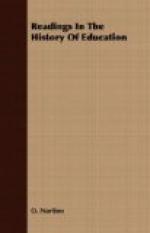At the beginning of the twelfth century three schools are distinguished in the contemporary literature above the multitude which had sprung into new life in France and were connected with so many of her cathedrals and religious houses. These three were at Laon, Paris, and Chartres. It would be more accurate to say, they were the schools of Anselm and Ralph, of William of Champeaux, and of Bernard Sylvester. For in those days the school followed the teacher, not the teacher the school. Wherever a master lived, there he taught; and thither, in proportion to his renown, students assembled from whatever quarter.... The tie was a personal one, and was generally severed by the master’s death. A succession of great teachers in one place was a rare exception; nor is such an exception afforded by the history of any of the three schools to which we have referred.[2]
In these days, when education requires a more and more elaborate equipment of buildings, libraries, laboratories, and museums, it is no longer possible for teachers, however distinguished, to attract throngs of students to places absolutely unprovided with the resources for teaching, or to provide these resources anywhere on the spur of the moment In the twelfth century, on the contrary, the only necessary equipment consisted in the master, his small library which could be carried by one man; wax tablets, or pens, ink, and vellum or parchment for the students; and any kind of a shelter which would serve as a protection from the weather. Not even benches or chairs were necessary, for students commonly sat upon the straw-strewn floors of the lecture rooms. Thus the school might easily follow the teacher in his migrations, and easily sink into obscurity or disappear upon his death or cessation from teaching. The autobiography of Abelard (see page 14), recounts an experience unusual in itself, but perfectly illustrative of the point. After relating various misfortunes and persecutions he continues:
So I betook myself to a certain wilderness previously known to me, and there on land given to me by certain ones, with the consent of the Bishop of the region, I constructed out of reeds and straw a sort of oratory in the name of the Holy Trinity where, in company with one of our clergy, I might truly chant to the Lord: “Lo I have wandered far off, and have remained in the wilderness.”
As soon as Scholars learned this they began to gather from every side, leaving cities and castles to dwell in the wilderness, and in place of their spacious homes to build small tabernacles for themselves, and in place of delicate food to live on herbs of the fields and coarse bread, and in place of soft couches to make up [beds of] straw and grass, and in place of tables to pile up sods.[3]
FOOTNOTES:
[Footnote 1: Adapted from Joseph McCabe, Abelard, pp. 7, 8.]




